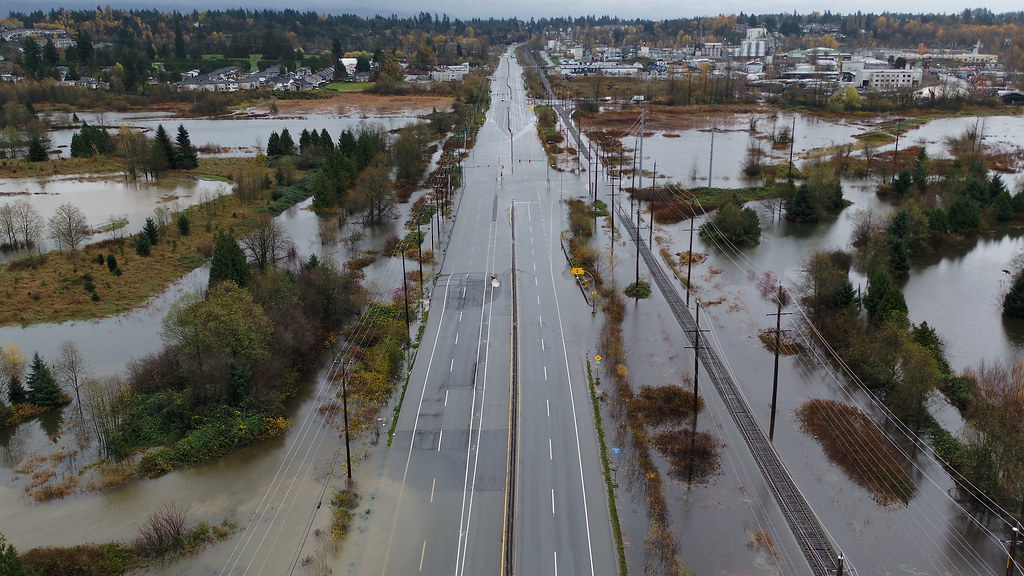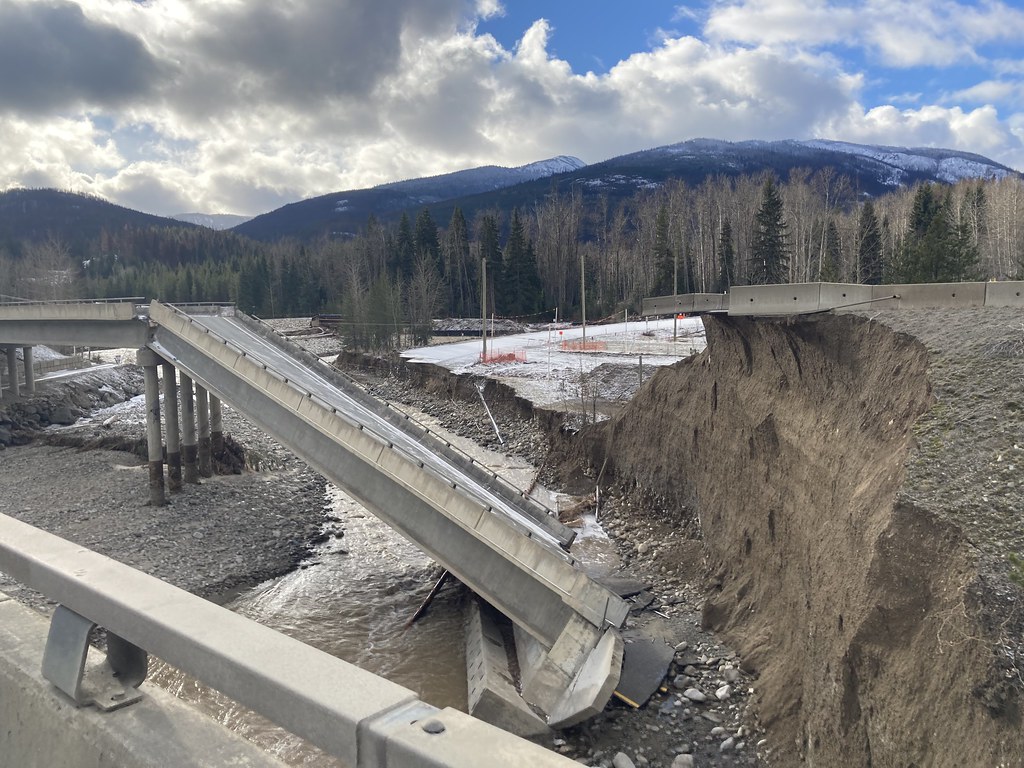
Torrential rains have caused devastation across British Columbia. Hundreds of people have been trapped by landslides, thousands have been forced to evacuate, and hundreds of thousands have gone without electricity. The city of Vancouver, the second largest port in North America, has been cut off from the rest of Canada. But this biblical-scale flooding is not a punishment from the gods. Capitalism has both created the climate crisis and also undermined our ability to prepare for and respond to extreme weather events.
A month of rain in three days
In just three days in early November, an entire month’s worth of rain fell on southern B.C. In Victoria, we saw 250 per cent the average rainfall of October and there are similar numbers across B.C. Combined with heavy rains in October, the waters began to overwhelm flood management infrastructure. In short order, three national highways connecting Vancouver to the rest of the province were impassable. Massive rains have washed out the Coquihalla and other major highways. While four deaths have been confirmed, many reports ominously warn that the number will rise as rescue teams search for bodies amongst the mud and debris.
The town of Merritt, which only months ago was under an evacuation order due to forest fires, was completely flooded when its wastewater system was inundated, forcing residents to flee. Similarly, the town of Princeton has been severely damaged as the Tulameen River overflowed its banks. Abbotsford, a major city in the Fraser Valley, is under threat of flood as a pump station used to drain the Sumas Prairie itself is under water. Over 1,000 evacuees have been trapped in the small town of Hope, while many others are streaming into the cities of the provincial interior.
However, cities in the interior haven’t escaped unscathed, as several mountain passes to Alberta have been closed as well. Some cities, such as Kelowna, are now effectively isolated, with no routes for essential goods to be transported in. Others are able to be supplied, but only by using longer and more difficult roads. In just a few days, shortages were reported across the province as grocery store shelves emptied out and gas stations ran dry.
The damages are catastrophic, with the Mayor of Abbotsford estimating the repair bill in that city alone as over $1B. Some effects have yet to be felt, such as the impact of farm animal deaths (estimated in the thousands) on the local food supply. And the economic impact on the rest of the country, with the port of Vancouver being cut off, is just starting to be felt.
In the provincial capital of Victoria, gasoline has become a scarce resource and unheard-of 50-car lineups have appeared at gas stations. A 30L maximum on gasoline has been imposed to ensure essential vehicles are able to continue operating.
But was there any way this disaster could have been avoided?
A foreseeable disaster
Certainly, heavy rains in Southern B.C. are as inevitable as the passage of one season into another. In fact, many local First Nations have traditions which include floods in their creation stories. While rainfall is normal, this level of rain was qualitatively different from past years. But it is not as though this was not foreseeable. In fact, study after study have all been pointing in the same direction: more rainfall and extreme weather in general.
According to a 2020 study from Environment and Climate Change Canada, climate change is making rainfall more extreme. As glaciers retreat, more water is entering the ecosystem, much of it in the form of extreme weather events. A study in 2019 predicted a four-fold increase in “atmospheric rivers” making landfall by the end of the 21st century.
More broadly, for years climate scientists have been warning that extreme weather events are going to become more frequent. Just this past summer B.C. was hit with a record heatwave and now record rainfall and flooding. And these things are all interrelated.
It should not be surprising that landslides are a major problem for the highways of the interior. The hillsides overlooking these highways are frequently the epicentre for forest fires and many have been left completely blackened after the summer fire season. The soil that is left over repels water instead of absorbing it.
Canadian astronaut Col. Chris Hadfield shared a photo of the massive plume of eroded soil flowing into the Pacific Ocean, with smaller plumes visible from river deltas on Vancouver Island. As climate change accelerates, a cycle is developing in which regions devastated by fires are then further damaged through flooding.
But as everyone knows, climate change did not come out of nowhere: it is human-made. But it is not just made by any humans, it is caused by human society organized in a certain way—it is the product of capitalism. As more and more people have become aware, we need “system change, not climate change.”
Criminal lack of preparation
But not only did capitalism create climate change in the first place, it also has led to a criminal lack of preparedness for what was obviously going to result. Despite knowing about the vulnerability of the province to flooding and the increasing likelihood of extreme weather events, a government discussion paper from June 2021 reported, “capacity and funding shortfalls at the provincial, regional, and local levels are frequent barriers to improved flood management.” Ironically, at the same time BC was flooding, the COP 26 Conference was failing to make any meaningful advance in the struggle against climate change.
The way we choose to handle these predictable events, and—critically—how much money the ruling class chooses to invest in flood management infrastructure, has a huge effect on our ability to withstand them. More rainfall condensed into shorter periods of time is going to become the norm and therefore, infrastructure must be built to cope with these extreme events. However, governments, while aware of these dangers, criminally did not prepare for them. While they were handing billions to private corporations, the problem of disaster preparedness was left unaddressed.
The same government discussion paper from June 2021 notes, “Major flood events in 1894,1948, and 1972 in B.C. triggered significant investments and policy and legislative responses. In contrast, long periods with no major flood disasters have tended to be followed by periods of lower investment in flood management policies, programs, and projects.”
The short-sightedness of capitalism is very visible here, as it seems the ruling class only concerns itself with flood mitigation when forced to by crisis. Of course, before billions can be spent on preventing floods, first billions must be lost to flood damages. Clearly the strategists of capital have never heard the famous quote by Benjamin Franklin: an ounce of prevention is worth a pound of cure.

B.C. government paralyzed
In response to this situation, the B.C. NDP government has been slow to act to say the least. It took several days of confusion for them to declare a state of emergency. They did not even use the province’s Alert Ready system, which sends text messages to cell phones across the province. They were also slow to impose restrictions on non-essential travel, rationing, and evacuation orders.
At the same time that the state has been slow to act when faced with this natural disaster, the RCMP has been sent to evict Indigenous land defenders who were enforcing an eviction notice against the Coastal Gaslink pipeline. This shows quite clearly the priorities of the capitalist state.
This has almost been a complete repeat of the government’s response (or lack thereof) to the heatwave which hit the Northwest this past summer. While it had been known that temperatures were rising and that infrastructure to deal with the heat was lacking, the lack of preparation was astounding.
Meanwhile, road crews have heroically been working around the clock to open up highways to much needed essential travel. As of the time of writing, a vital link between Vancouver and the interior has been re-established. Traffic will be reduced to only the most necessary goods, services, and people for several weeks.
Climate and class
But the destruction wrought by climate change is not felt equally. This disaster has fallen hardest on the workers and farmers whose homes are on flood plains. It is felt by the people in the small towns and cities of the interior who rely on goods from the coast. It is felt by people who cannot miss a day of work, even when the roads get washed out and the buses can’t run.
Conversely, the capitalist class will be the last to feel these effects. Their homes are already flood resistant or else in the penthouses of Vancouver. Their groceries are delivered by workers and if they work at all, they can do so from home. Climate change is of critical importance to the workers but barely registers in the minds of the capitalists as they don’t feel the effects as acutely.
The reality is that under capitalism, infrastructure to mitigate disasters will always be underfunded and an afterthought for rich developers. Workers will have their homes flooded and roads destroyed because of the profit motive and the “free” market. The wealth to build this infrastructure exists in the glass and concrete towers overlooking Robson Square, but it will only be mobilized at the eleventh hour to save the profits of the capitalist class.
As this disaster proves, the eleventh hour is usually too late. The working class cannot wait for capitalism to save us. What is desperately needed is a socialist plan of production to rapidly build out flood resistant housing and infrastructure. These houses could also be equipped with energy efficient insulation and air conditioning for the increasingly hot summers. We need highways and bridges that won’t wash away, storm drains and floodplains that can do the job, and support systems for the elderly and disabled for when hard times hit.
The capitalist class cannot be trusted to manage the climate crisis, as they’ve proved over and over again. What is needed is a revolution to take the power from their hands and put it in the hands of the working class. We know how to protect our communities and workplaces, but we must have power to follow through. Above all, what is needed is a revolutionary party that can mobilize the workers in this fight. If you agree with us and want to join the struggle, contact us!

